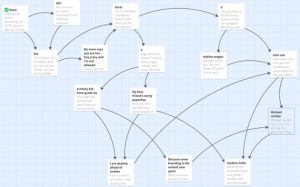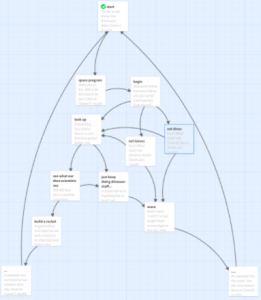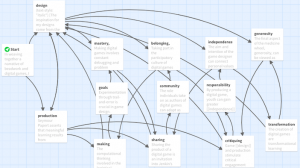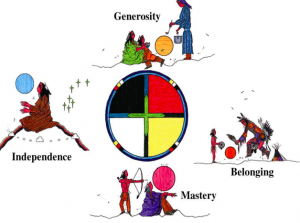“If there is any one thing upon which this ‘intelligence depends’ it would seem to be organization” (Englebart, Douglas. 1963).
The way information is organized in Valerie Ireland’s post, “Task Five – Twine and Hypertext” as a first time Twine user explores the concept of ‘what if’ through the game MASH, is compared and contrasted with the two projects I present in “Twine Time” that I developed over the course of two MET courses on Games and Learning on the cyclical and iterative nature of learning in, ‘Her earrings are complex’ and an environmental awareness game of, ‘Era’.

Overview of pathways in ‘What if’ by Valerie Ireland
Valerie presents her perspective in the last slide of her Twine; “I see life as hypertext. A series of connections, networks which are flexible, dynamic and agentic.” Whereas, my ideas present the perspective that “Hyperlinks create a mirage of control, where the reader only had choice over what is presented and therefore lacks the ability to follow their own path.” In contrasting ‘agentic’ and ‘mirage of control,’ I find that the networks and paths created in virtual space are called in to question. In the Twines presented, the reader was led along a predetermined path and had choices in order to navigate the route, but could not stray from the predetermined path. The idea of what if in MASH provides the mirage of choice and fate, but shed light on the predetermined paths in both life and hypertext.

Pathways in ‘Era’ by Emily Saundercook
With exception to the first two slides of ‘Era’ where audio of the text is provided, ableism underpins accessibility to the Twine platform. Ableism in constructed in text-based games, where barriers are created to limit the participation of blind, visual impaired and illiterate. The support of visual descriptions and music in Era help the player to determine the mood and tone of the game, however, limit access to a portion of viewers through the lack of audio recording of the text. The interactivity of the text is shaped by oral culture, yet are disabled from accessing the content by excluding audio.
Another aspect of the organization of information in Twine which affects the user experience is the use of first and second person language. The style of language changes the tone and effects the perceived agency of the player. The games ‘Era’ and ‘What if’ use second person language in asking questions to the player as ‘you.’ In Valerie’s game, the text throughout the game follows a similar pattern where the user can feel in control of their own choices, while navigating a predetermined path. (Text is bold symbolizes hypertext options).
Can you tell my MASH fortune?
Choice One: Sure!
Choice Two: My mom says you are too boy crazy and I’m not allowed
Either choice will bring you to the same ending, similar to the game Era, where the structure has two possible end game outcomes. The player’s choices in Era are limited from the start and the player only has two options before they are funnelled into a singular choice. In ‘Era,’ the text challenges the player to choose between focus on the individual or collective world.
Interesting… You notice there’s a star that has gotten bigger and bigger every night for a while now. What would you like to do?
see what our dino scientists say
just keep doing dinosaur stuff…
Valerie writes in her blog that “My post has a ‘butterfly effect’ feeling to looking back on how choices have shaped my existence. And how life, like hypertext, life is fluid and multilinear.” Reflection on choice shaped the organization of the information, can inform the reader of aspects of societal privilege. By thinking of yourself versus others in ‘Era’ and of the random assignment of lifestyle affordances through the game MASH, the user can reflect on issues of class, gender, race and worldview. In MASH the options vary from a mansion to a shack and are randomly assigned, however, in critiquing this game one can ask, similar to hypertext, are the life choices of all people randomly assigned or are they predetermined based on societal norms?
Alternatively, in the Twine ‘Her earrings are complex,’ I reflect on the organization of a Twine project as cyclical and iterative from of learning from the first person perspective. In the post Twine Time, I write, “The organization of hypertext can be related to trees of information, similar to the nodes and pathways of Twine. By connecting ideas through hyperlinks, these pathways denote a series or sequence of ideas to organize the thought processes.” The overlap of links in ‘Her earrings are complex’ allow the viewer to navigate based on the connections they make and create their own pathways of sequencing the information. In revisiting Valerie’s point that life as hypertext is flexible, dynamic and agentic, I would argue that the way in which hypertext is constructed can enable an agentic user experience, if the Twine has two-way links that facilitate user-driver direction.

Pathways in ‘Her earrings are complex’ by Emily Saundercook
Exemplified through the ‘Design’ pathway, the contrast of personal narrative and academic research demonstrate the constructivist notions of weaving personal experience with challenging ideas to one’s worldview in order to reflect and create new knowledge. The text on design slide includes:
The inspiration for my designs come from the women who taught me to bead. The ladies who sat around a kitchen table drinking labrador tea, speaking quickly in Cree and laughing more than beading. Their beadwork, representative of their love and care for one another, embodied how we built resiliency together as family and community to the challenges we encounter in life.
The medicine wheel presented by Dr. Martin Brokenleg, addresses teaching to the heart of people, as opposed to just the mind, by fostering belonging, mastery, independence and generosity. In our work and production, we must carry these principles in order to internalize our learning.
The personal story is contrasted by calling in the viewer to the conversation by saying we must carry these principles in order to internalize our learning. The individual and collective vision are prioritized though the first person narrative of learning and process, as interwoven with the call to action guided by research and an appeal to adapt and change. This leads to further questions of how the organization and portrayal of information influences the construction of individual and collective knowledge. Is there a difference between being led by hypertext online through the process of associative information and clicking to progress through a Twine game? Is the user making choices based on their own thinking or on strategic game play? Should hypertext online, which is leading the user along a path to discovery, be perceived as strategic game play by web developers and software companies?
References:
Baviskar, S. N., Hartle, R. T., & Whitney, T. (2009). Essential criteria to characterize constructivist teaching: Derived from a review of the literature and applied to five constructivist teaching method articles. International Journal of Science Education, 31(4), 541-550.
Englebart, Douglas. (1963). “A conceptual framework for the augmentation of man’s intellect .” In Hawerton, P.W. and Weeks, D.C. (Eds.), Vistas in information handling, Volume I: The augmentation of man’s intellect by machine. Washington, DC: Spartan Books. Available (as “Augmentation of human intellect: A conceptual framework”)
Knight, J. on Identity-first vs. person-first language, A11y Rules Podcast Episode 32. [39 mins.]
